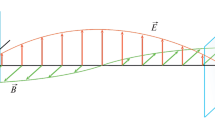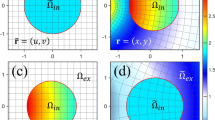Abstract
Based on mode coupling theory, the general form of coupled second order differential equations for the longitudinal rf standing-wave amplitudes in a complex cavity with gradual transition is developed. The TM type non-principal modes generated due to mode conversion are systematically taken into account. Comparisions of numerical results including or excluding TM modes are made for several examples and some interesting results are obtained.
Similar content being viewed by others
References
V. E. Zapevalov, S. A. Malygin, V. G. Pavel'ev, Coupled resonator gyrotrons with mode conversion,Radiofizika, 1984,27, 846–852.
S. A. Malygin, Powerful gyrotron operating at the third harmonic,Radiotekhnika i Elektronika,31, 334–336.
H. Guo, D. J. Hoppe, J. R. Rodgers, Phase-locking of a second-harmonic gyrotron oscillator using a quasi-optical circular to separate injection and output signals,IEEE Trans. on Plasma Sciences, 1995,23, 822–832.
V. G. Pavel'ev, SH. E. Tsimring, V. E. Zapevalov, Coupled cavities with mode conversion in gyrotrons,Int. J. Electronics, 1987,63, 379–391.
O. Dumbrajs, E. Borie, A complex cavity with mode conversion for gyrotrons,Int. J. Electronics, 1988,65, 285–295.
J. M. Neilson, P. E. Latham, M. Caplan, Determination of the resonant frequencies in a complex cavity using the scattering matrix formulation,IEEE Trans. on Microwave Theory and Techniques, 1989,37, 1165–1170.
S. A. Malygin, V. G. Pavel'ev, SH. E. Tsimring, Resonance mode conversion in oversized electrodynamic systems,Radiofizika, 1983,26, 1126–1133.
D. Wagner, G. Gantenbein, W. Kasparek, M. Thumm, Improved gyrotron cavity with high quality factor,Int. J. of Infrared and Millimeter waves, 1995,16, 1481–1489.
G. Gantenbein, E. Borie, G. Dammertz, Experimental results and numerical simulations of a high power 140 GHz gyrotron,IEEE Trans. on Plasma Sciences, 1994,22, 861–869.
A. Jöstingmeier, C. Rieckmann, A. S. Omar, Computation of the irrotational magnetic eigenfunctions belonging to complex cavities,IEEE Trans. on Microwave Theory and Techniques, 1994,42, 2285–2293.
A. Jöstingmeier, C. Rieckmann, A. S. Omar, Rigorous and numerically efficient computation of the irrotational electric and magnetic eigenfunctions of complex cavities,IEEE Trans. on Microwave Theory and Techniques, 1995,43, 1187–1195.
H. F. Li, M. Thumm, Mode coupling in corrugated waveguides with varying wall impedance and diameter change.Int. J. of Electronics,71, 827–844.
Author information
Authors and Affiliations
Rights and permissions
About this article
Cite this article
Yang, S., Li, H. A rigorous study of the rf fields in complex cavities with gradual transitions. Int J Infrared Milli Waves 17, 1895–1906 (1996). https://doi.org/10.1007/BF02069463
Received:
Issue Date:
DOI: https://doi.org/10.1007/BF02069463




